As teacher shortages hit classrooms across the country, the federal education minister, Jason Clare, is meeting his state and territory counterparts on Friday to address the problem. Their challenge is how to find more than 4000 new secondary teachers by 2025.
A solution might be hiding in plain sight, as evidenced by the experience at various schools not far from where the ministers are meeting.

But does the distribution of teachers add up?
Two disadvantaged high schools, just over the border in Queanbeyan, have about one teacher for every 10 students. Such a level of support is critically important in these schools. But at nearby Canberra Girls Grammar, the ratio is under 10. And there are low student/teacher ratios, too, at Canberra’s Daramalan Catholic College, Radford College and Canberra Grammar. How have Australia’s poorest and richest schools, with their very different needs, ended up being staffed at similar levels? And, in any case, do the advantaged students truly benefit from such close attention?
If Australia’s teachers were more equitably distributed, our teacher-supply problem would be significantly eased. This would be especially so in NSW, Victoria and Western Australia. Public schools and some Catholic schools are being starved of teachers while, in number terms, wealthier independent schools have a surplus.
The numbers tell the story. Independent schools in major cities had an overall student-teacher ratio of 11.72 to one in 2018 – the last year before teacher shortages began to be noticed. In the same year, government schools had an average ratio of 14.73 to one, although it could be as high as 16.
If independent schools were staffed at the same level as government schools, they would have required about 32,000 teachers. But they employed about 40,000 – 25 per cent more than would have been needed if the same staffing standards had been applied to them as applied in public schools and, for the most part, in Catholic systems. At an average salary of about $80,000, those 8000 additional teachers would have cost more than $500 million. In the light of overall needs, was it a good investment?
Some might say it pays off in better results. But it doesn’t. The evidence shows that schools with similar demographics produce similar results. Anyone can use the My School website to see the impact of socio-economic status of school enrollments on students’ results. Comparisons of apples with apples show public schools achieve much the same results as independent schools, at a lower cost and with less favorable student/teacher ratios. Imagine what most public schools could achieve with better teacher resourcing.
loading
Others might say the funding of independent schools comes from parents, and if this helps pay for more teachers in those schools, so what? But private schools also receive taxpayer funding, and the bigger question is how much should that public money prop up a system that distributes more of a scarce resource – in this case teachers – to those who need them least?
